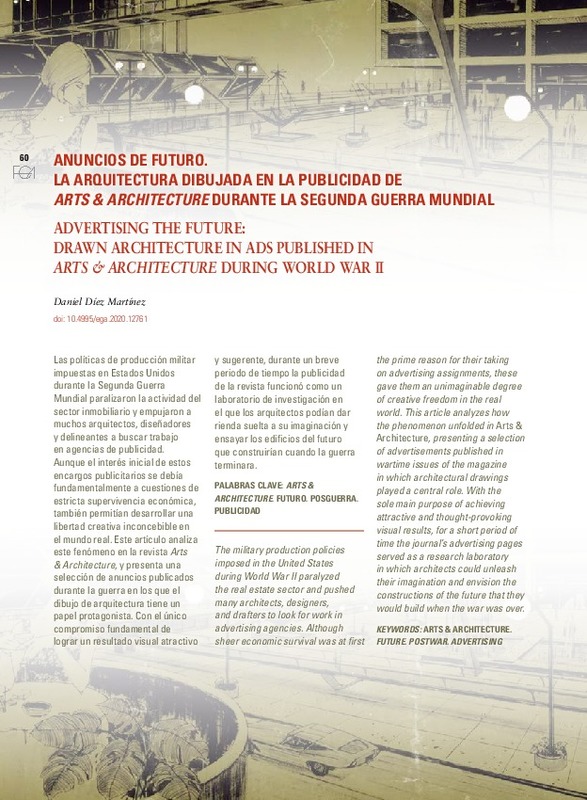JavaScript is disabled for your browser. Some features of this site may not work without it.
Buscar en RiuNet
Listar
Mi cuenta
Estadísticas
Ayuda RiuNet
Admin. UPV
Anuncios de futuro. La arquitectura dibujada en la publicidad de Arts & Architecture durante la Segunda Guerra Mundial
Mostrar el registro sencillo del ítem
Ficheros en el ítem
| dc.contributor.author | Díez Martínez, Daniel
|
es_ES |
| dc.date.accessioned | 2020-09-09T11:37:07Z | |
| dc.date.available | 2020-09-09T11:37:07Z | |
| dc.date.issued | 2020-07-22 | |
| dc.identifier.issn | 1133-6137 | |
| dc.identifier.uri | http://hdl.handle.net/10251/149676 | |
| dc.description.abstract | [ES] Las políticas de producción militar impuestas en Estados Unidos durante la Segunda Guerra Mundial paralizaron la actividad del sector inmobiliario y empujaron a muchos arquitectos, diseñadores y delineantes a buscar trabajo en agencias de publicidad. Aunque el interés inicial de estos encargos publicitarios se debía fundamentalmente a cuestiones de estricta supervivencia económica, también permitían desarrollar una libertad creativa inconcebible en el mundo real. Este artículo analiza este fenómeno en la revista Arts & Architecture, y presenta una selección de anuncios publicados durante la guerra en los que el dibujo de arquitectura tiene un papel protagonista. Con el único compromiso fundamental de lograr un resultado visual atractivo y sugerente, durante un breve periodo de tiempo la publicidad de la revista funcionó como un laboratorio de investigación en el que los arquitectos podían dar rienda suelta a su imaginación y ensayar los edificios del futuro que construirían cuando la guerra terminara. | es_ES |
| dc.description.abstract | [EN] The military production policies imposed in the United States during World War II paralyzed the real estate sector and pushed many architects, designers, and drafters to look for work in advertising agencies. Although sheer economic survival was at first the prime reason for their taking on advertising assignments, these gave them an unimaginable degree of creative freedom in the real world. This article analyzes how the phenomenon unfolded in Arts & Architecture, presenting a selection of advertisements published in wartime issues of the magazine in which architectural drawings played a central role. With the sole main purpose of achieving attractive and thought-provoking visual results, for a short period of time the journal’s advertising pages served as a research laboratory in which architects could unleash their imagination and envision the constructions of the future that they would build when the war was over. | es_ES |
| dc.language | Español | es_ES |
| dc.language | Inglés | es_ES |
| dc.publisher | Universitat Politècnica de València | es_ES |
| dc.relation.ispartof | EGA Expresión Gráfica Arquitectónica | es_ES |
| dc.rights | Reconocimiento - No comercial - Sin obra derivada (by-nc-nd) | es_ES |
| dc.subject | Arts & Architecture | es_ES |
| dc.subject | Future | es_ES |
| dc.subject | Postwar | es_ES |
| dc.subject | Advertising | es_ES |
| dc.subject | Futuro | es_ES |
| dc.subject | Posguerra | es_ES |
| dc.subject | Publicidad | es_ES |
| dc.title | Anuncios de futuro. La arquitectura dibujada en la publicidad de Arts & Architecture durante la Segunda Guerra Mundial | es_ES |
| dc.title.alternative | Advertising the future: drawn architecture in ads published in Arts & Architecture during World War II | es_ES |
| dc.type | Artículo | es_ES |
| dc.identifier.doi | 10.4995/ega.2020.12761 | |
| dc.rights.accessRights | Abierto | es_ES |
| dc.description.bibliographicCitation | Díez Martínez, D. (2020). Anuncios de futuro. La arquitectura dibujada en la publicidad de Arts & Architecture durante la Segunda Guerra Mundial. EGA Expresión Gráfica Arquitectónica. 25(39):60-73. https://doi.org/10.4995/ega.2020.12761 | es_ES |
| dc.description.accrualMethod | OJS | es_ES |
| dc.relation.publisherversion | https://doi.org/10.4995/ega.2020.12761 | es_ES |
| dc.description.upvformatpinicio | 60 | es_ES |
| dc.description.upvformatpfin | 73 | es_ES |
| dc.type.version | info:eu-repo/semantics/publishedVersion | es_ES |
| dc.description.volume | 25 | es_ES |
| dc.description.issue | 39 | es_ES |
| dc.identifier.eissn | 2254-6103 | |
| dc.relation.pasarela | OJS\12761 | es_ES |
| dc.description.references | AUERBACH, A., 1962. Modern design - Historical notes. Arts & Architecture, March 1962, p. 16. | es_ES |
| dc.description.references | AYNSLEY, J., 2012. Developing a Language of Vision: Graphic Design in California; in KAPLAN, W. and ADAMSON, G. (eds.) California Design, 19301965: Living in a Modern Way. Los Angeles: Los Angeles County Museum of Art, pp. 263-288. | es_ES |
| dc.description.references | BANNISTER, T.C. and BELLAMY, F.R., 1954. The Architect at Mid-Century. Evolution and Achievement. New York: Reinhold. | es_ES |
| dc.description.references | COLOMINA, B. 2006. La Domesticidad en Guerra. Barcelona: Actar. | es_ES |
| dc.description.references | HINE, T., 1998. The Search for the Postwar House; in SMITH, E.A.T. (ed.) Blueprints for Modern Living: History and Legacy of the Case Study Houses. Cambridge: The MIT Press, p. 167-182. | es_ES |
| dc.description.references | MAGINNIS, C.D., 1944. Musings on the Morrow. Journal of the American Institute of Architects, January 1944, pp. 10-13. | es_ES |
| dc.description.references | SHANKEN, A.M., 2009. 194X. Architecture, Planning, and Consumer Culture on the American Home Front. Minneapolis: University of Minnesota Press. | es_ES |
| dc.description.references | SHANKEN, A.M., 2010. Breaking the Taboo: Architects and Advertising in Depression and War. Journal of the Society of Architectural Historians, Vol. 69 No. 3, pp. 406-429. https://doi.org/10.1525/jsah.2010.69.3.406 | es_ES |
| dc.description.references | SHREVE, R.H., 1942. The Outlook of the Profession. The Octagon, January 1942, pp. 3-4. | es_ES |








